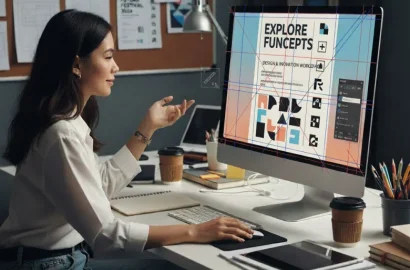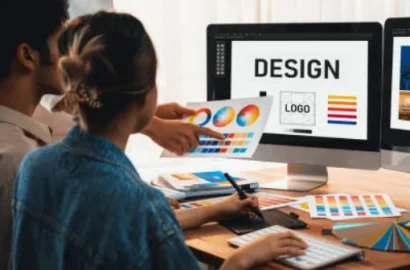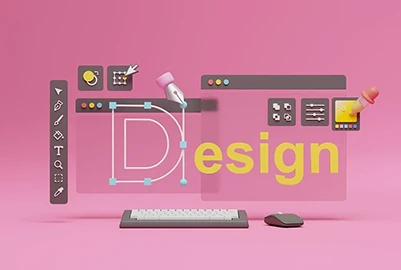Curious about how much you could make as a graphic designer in India? We’ve got all the information you need, from graphic design salaries and job profiles to factors influencing pay, in this comprehensive guide.
Over the past decade, as India has become a center for design, innovation, and technology, the demand for skilled graphic designers has surged. Organizations in the country are increasingly prioritizing user-centered designs, as well as harnessing the skills of talented graphic designers to shape digital products, services, and experiences to help retain customers and boost revenue.
If you’re wondering how much you can earn as a graphic designer, you’ve landed at the right place. In this guide to graphic design salary in India, we’ll walk you through the average salaries of graphic designers, their roles and responsibilities, diverse job profiles, and industries that pay the highest salaries. Additionally, we’ll cover essential skills to develop for salary negotiation, factors that impact your salary offers, and actionable tips on how to become a graphic designer.
Here’s a clickable list of everything that we’ll be covering in this article!
Contents:
- What Are the Roles and Responsibilities of Graphic Designers?
- What Is the Average Salary of a Graphic Designer in India?
- What Are the Various Graphic Designer Job Profiles and Their Salaries?
- What Factors Affect Graphic Designer Salaries in India?
- Graphic Designer Salaries Based On Cities
- Graphic Designer Salaries Based On Industries
- What Are the Skills Needed To Upgrade Your Graphic Designer Salary?
- How To Become a Graphic Designer in India?
- Way Forward
What Are the Roles and Responsibilities of Graphic Designers?
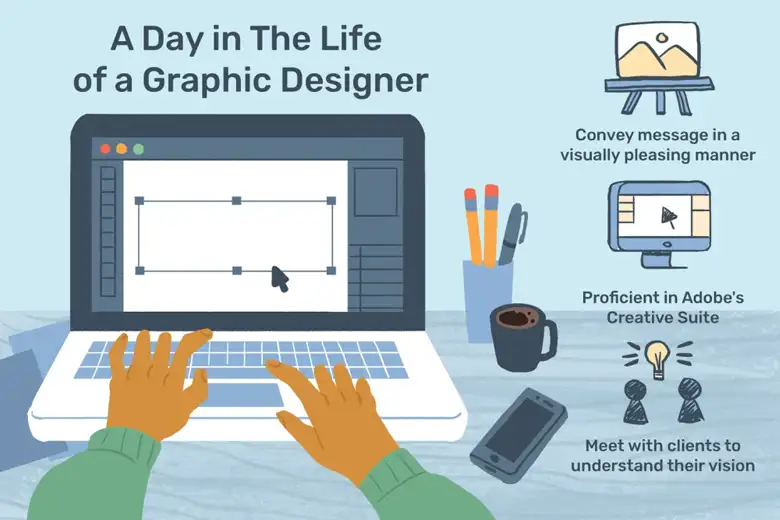
Image Courtesy: Live About
Before learning about the average graphic designer’s salary in India, let’s first understand their roles and responsibilities. Graphic designers develop visual concepts and create brand identities that effectively convey the information to the audience and inspire them to take action. They design everything from logos and posters to ad campaigns, billboards, print materials, websites, and product packaging. Graphic designers can work in-house, creating designs specifically for one brand, at an agency, or as freelancers working with a variety of clients.
While the scope of work may vary depending on the company, here is an outline of the major responsibilities typically expected of a graphic designer in leading organizations:
– Ability to design, structure, format, and supervise print production.
– Using advanced software to create illustrations, logos, ads, and other design collateral.
– Finalising color scheme, typography, font size, and style.
– Collaborating with brands, writers, and marketers to formulate unique visuals for products, campaigns, or websites.
– Communicating with clients, understanding their requirements, and responding to their feedback.
What Is the Average Salary of a Graphic Designer in India?
The average salary of graphic designers in India varies widely based on factors such as location, skills, and company size. Starting salaries for graphic designers in India typically range from INR 2 lac to 3 lacs per annum. Freshers can expect to earn between INR 3 lacs and INR 4.5 lacs per year on average.
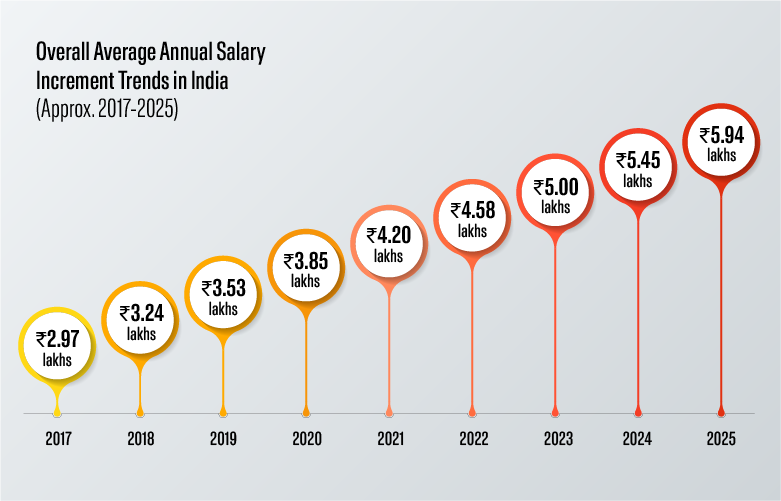
The figures are higher for experienced professionals. Senior graphic designers in India can earn up to INR 10 lacs annually. Freelance graphic designers have a broader range, with earnings between INR 4.8 lacs to 8 lacs per year, depending on their workload and clientele.
The highest salaries of graphic designers in India can reach up to INR 20 lacs, with senior-level positions in top firms or multinational companies offering between INR 10 lacs and INR 15 lacs or even more.
Source: Glassdoor
What Are the Various Graphic Designer Job Profiles and Their Salaries?
Graphic designers can pursue various job profiles based on their skills, interests, and experience levels. Here are some insights into some graphic designer job profiles and their salaries:
1. Creative Graphic Designer
A creative graphic designer is responsible for planning and projecting visual communication through the combination of words, design elements, color schemes, and fonts. This role involves understanding client needs, ideating and brainstorming concepts, assisting senior graphic designers, developing brand identities, and creating visually appealing designs that effectively convey the brand message.
The average salary of a creative graphic designer in India is INR 3-6 lacs per annum.
2. Senior Graphic Designer
A senior graphic designer supervises all aspects of graphic design projects. This role includes leading design projects, managing infographics and illustrations created for emails and social media posts, mentoring junior designers, and developing strategies.
The average salary of a senior graphic designer in India can go up to INR 10 lacs or more per annum.
3. Logo Designer
A logo designer creates distinct and customized logos for individuals or companies by understanding brand vision and identity. This involves developing visuals and presenting logo design options of various mediums and sizes. Logo designers can be full-time employees or freelancers at advertising agencies or design firms.
The average salary of a logo designer in India is INR 2-3 lacs per annum.

Image Courtesy: Online Degree
4. Motion Graphic Designer
A motion graphic designer creates artwork for television, web, or film in the form of trailers, commercials, movie clips, and title sequences. The work involves combining graphic design with animation, visual effects, and cinematic techniques to produce realistic visuals through design concepts and storyboarding. Motion graphic designers often collaborate with video editors and content creators.
The average salary of a motion graphic designer in India is INR 4-6 lacs per annum.
5. Web Designer
A web designer creates visually attractive user interfaces and experiences for websites. This involves creating high-fidelity wireframes and prototypes and designing layouts, including logos, fonts, color schemes, images, and written content. Web designers collaborate with other designers and developers to improve the user experience by designing intuitive navigation and responsive layouts. They also conduct usability tests and continuously optimize the design based on feedback and performance.
The average salary of a web designer in India is INR 3-7 lacs per annum.
Freelance Graphic Designer
A freelance graphic designer works independently to create visual content for clients across various industries. This includes designing brochures, logos, advertisements, social media posts, banners, and other visual materials. Freelance graphic designers manage their projects from start to end, ensuring that the design meets the client’s expectations. They often work remotely, communicating with clients via email, video calls, or project management tools, and have work flexibility.
Earnings vary depending on workload, experience, and client base. However, they typically range from INR 3-7 lacs per annum.
What Factors Affect Graphic Designer Salaries in India?
There are multiple factors that influence the salary structure of graphic designers in India. Below are some of the significant factors:
Years of Experience
The number of years graphic designers spend in the industry provides valuable insights into the design process, understanding brands, target audiences, and client interactions. This experience improves their ability to execute projects effectively and significantly contributes to their financial growth.
Educational Background and Certifications
Having a master’s degree or certification in graphic design or relevant subjects is a huge plus for a candidate. Employers often value these qualifications, as they indicate a higher level of expertise and commitment to the profession. As a result, candidates with advanced degrees or certifications are typically able to negotiate higher salaries and secure more desirable positions.

Image Courtesy: Team People
Skills
Possessing industry-relevant skills or learning new ones significantly increases the potential for earning higher salaries, especially for those in senior graphic designer positions. Staying updated about the latest software, design trends, and technologies can set graphic designers apart from the competition. As designers advance in their careers, their ability to leverage these skills positions them for promotions and raises.
Performance
Performance is a critical factor in determining a graphic designer’s salary and career progression. Consistently delivering high-quality work, meeting deadlines, and exceeding client expectations can lead to recognition and opportunities. Exceptional performance often results in promotions to senior roles, which come with increased responsibilities and higher salaries. Additionally, strong performance reviews can lead to bonuses and merit-based raises.
Location
Different regions offer varying compensation based on local market conditions, cost of living, and demand for design professionals. For example, metropolitan cities like Mumbai, Bangalore, and Delhi tend to offer higher salaries due to the higher cost of living and greater demand for skilled designers. Understanding these regional differences is important for designers when considering job opportunities and negotiating salaries. Being located in a region with a thriving design industry can provide better financial prospects and career opportunities.
Company Size
Larger graphic design companies have more resources and higher budgets, allowing them to offer higher salaries and additional benefits. These companies may also provide more opportunities for career growth, professional development, and access to modern design tools and technology. On the other hand, smaller companies or startups might offer lower initial salaries but can provide a more diverse range of responsibilities and the potential for rapid advancement as the company grows. Working in a smaller company may allow designers to have a greater impact on the company’s projects and brand direction. Understanding the relevance of company size can help graphic designers make informed decisions about their career paths and salary expectations.
Graphic Designer Salaries Based On Cities
A graphic designer’s salary strongly depends on the location of the job. Let’s take a look at some major Indian cities and their average graphic designer salary offers.
|
City |
Average Salary Per Annum |
|---|---|
|
1. Mumbai |
INR 4 lacs |
|
2. Bengaluru |
INR 5 lacs |
|
3. Delhi |
INR 3.3 lacs |
|
4. Pune |
INR 3.3 lacs |
|
5. Hyderabad |
INR 3.3 lacs |
|
6. Chennai |
INR 3.3 lacs |
|
7. Noida |
INR 3.3 lacs |
Source: AmbitionBox
Graphic Designer Salaries Based On Industries
Graphic designer salaries in India can vary significantly depending on the industry. Here’s an overview of how salaries tend to differ across various sectors:
|
City |
Average Salary Per Annum |
|---|---|
|
1. Advertising and Marketing |
INR 3-8 lacs |
|
2. IT Services and Consulting |
INR 3.7-9 lacs |
|
3. E-commerce |
INR 3-7 lacs |
|
4. Publishing and Printing |
INR 2-5 lacs |
|
5. Media and Entertainment |
INR 2.5-6 lacs |
|
6. Education and Training |
INR 2-5 lacs |
|
7. Corporate/In-house Design |
INR 3-7.5 lacs |
|
8. Startups |
INR 3-10 lacs |
|
9. Freelance/Independent |
INR 3-15 lacs + |
Source: AmbitionBox
Note: These figures are approximate and can vary based on factors like experience and specific skills.
What Are the Skills Needed To Upgrade Your Graphic Designer Salary?

Renowned companies and recruiters are always on the lookout for exceptionally skilled graphic designers. While the required skills and scope of work can vary depending on the company, acquiring the following expertise, along with a minimum of 2-3 years of experience, can help graphic designers bag lucrative offers:
– Proficiency in Adobe Creative Suite, including Photoshop, Illustrator, and InDesign
– Basic understanding of UX/UI design, including wireframing tools like Figma and Miro
– Web design and development
– Typesetting
– Video editing and animation
– Social media content creation
– Communication
– Branding
– Time management
– Pricing strategies and project estimation
– Client management
By developing these skills, you can position yourself for higher-paying roles, take on more complex projects, and potentially transition into leadership positions in this industry.
How To Become a Graphic Designer in India?

Image Courtesy: ESS Institute
Becoming a graphic designer in India involves a combination of education, skill development, and practical experience. Here’s a detailed process that includes:
1. Education
- Choose a Relevant Degree: Enroll in a Bachelor’s degree program such as a Bachelor of Arts (BA) in graphic design, Bachelor of Design (B.Des) in graphic design, or Bachelor of Science (B.Sc) in graphic design. Other alternatives include diploma or postgraduate diploma courses in graphic design.
- Institutions: Consider online platforms and reputed institutions like the National Institute of Design (NID), National Institute of Fashion Technology (NIFT), Symbiosis Institute of Design, AND Academy, and various private and government colleges.
- Curriculum: Study subjects like typography, colour theory, digital design, illustration, branding, and advertising.
2. Skill Development
- Software Proficiency: Learn essential design software such as Adobe Creative Suite (Photoshop, Illustrator, InDesign), Corel Draw, and other relevant tools.
- Web and UI/UX Design: Gain basic knowledge of HTML, CSS, and user interface/user experience design.
- Typesetting and Layout: Understand the principles of typesetting and layout design for print and digital media.
- Video Editing and Animation: Acquire skills in video editing and animation software like Adobe After Effects and Premiere Pro.
3. Build a Portfolio
- Create a Diverse Portfolio: Develop a graphic design resume and portfolio showcasing a variety of projects, such as logos, brochures, websites, and social media graphics. For portfolio inspiration, see this social media narrative project by AND learner Bibin S.
- Personal Projects and Freelancing: Work on personal projects, internships, or freelance assignments to gain practical experience and elevate your portfolio.
4. Internships and Work Experience
- Internships: To gain hands-on experience, apply for internships at design studios, advertising agencies, or corporate design departments.
- Networking: Build connections with industry professionals through events, online forums, and social media platforms like LinkedIn and Behance.

5. Advanced Education and Certifications
- Master’s Degree: Consider pursuing a Master’s degree in graphic design, visual communication, or a related field for advanced knowledge and better job prospects.
- Certifications: Obtain certifications in specialized areas such as UI/UX design, digital marketing, or motion graphics from recognized institutions or online platforms.
6. Job Search and Career Development
- Apply for Jobs: Look for job openings in advertising agencies, design studios, publishing houses, media companies, and IT firms.
- Resume and Portfolio: Customise your resume and portfolio to align with the job requirements.
- Continuous Learning: Stay updated with the latest design trends, software, and technologies through online courses, workshops, and industry publications.
- Join Professional Associations: Become a member of professional organizations like the Association of Designers of India (ADI) to access resources and networking opportunities.
7. Freelancing and Entrepreneurship
- Freelance Work: Many graphic designers choose to work as freelancers, offering services to a range of clients. Building a strong online presence and maintaining a portfolio on platforms like Behance and Dribble can attract potential clients.
- Starting a Design Studio: With sufficient experience and a solid client base, some graphic designers start their own design studios or agencies.
Way Forward
In this comprehensive guide, we’ve highlighted diverse job profiles, average salaries of graphic designers across India, and provided a step-by-step guide on how to become a graphic designer. To reiterate, when applying for a job, thoroughly research salaries and consider factors like company size and location. This will give you a good indication of what you should expect and leave you in a stronger position to make the right choice. With our hands-on advice, we hope you’re better informed of the value you bring to the table as a graphic designer and feel confident negotiating the salary that’s right for your skills and experience.
If you’re considering learning more about graphic design and launching an exciting new career in the space, check out the Graphic Design Course offered by AND, which comes with a comprehensive curriculum, hands-on learning opportunities, unparalleled mentorship, and dedicated placement support.
To learn more about graphic design, head over to the AND Academy blog for similar articles. As a starting point, you can consider going through the following resources:
1. Why You Should Pursue a Graphic Design Course?
2. The 11 Best Graphic Design Jobs in Delhi to Watch Out for
3. The 7 Best Free Graphic Design Courses to Consider
Next Steps
We hope that through this article we’ve been able to show why understanding graphic designer salaries and industry factors is crucial for establishing a successful career in the field.
If you still have unanswered questions about pursuing graphic design, consider these additional resources for further information:
- Watch this session by graphic design industry leaders Soumya Tiwari and Sakshi Jain.
- Talk to a course advisor to discuss how you can transform your career with one of AND Academy’s courses.
- Explore our Graphic Design Course, which is taught through live, interactive classes by industry experts, and comes with a job guarantee.
- Take advantage of the scholarship and funding options that come with our courses to overcome any financial hurdle on the path of your career transformation.
Note: All information and/or data from external sources is believed to be accurate as of the date of publication.




